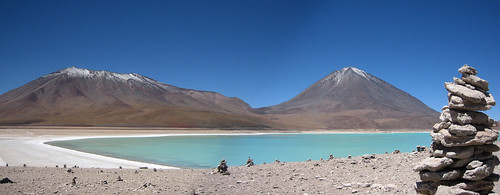Lakes in the Atakama desert
The Atacama Desert is a virtually rainless plateau in South America, covering a 966 km (600 mi) strip of land on the Pacific coast of South America, west of the Andes mountains.
The Atacama desert is, according to NASA, National Geographic and many other publications, the driest desert in the world. The rain shadow on the leeward side of the Chilean Coast Range and the Andes, as well as a coastal inversion layer created by the cold offshore Humboldt Current, keep this over 20 million-year-old desert 50 times drier than California's Death Valley.
The Atacama occupies 181,300 square kilometers (70,000 mi²) in northern Chile, composed mostly of salt basins (salares), sand, and lava.
The Atacama is one of the driest places on Earth, and is virtually sterile because it is blocked from moisture on both sides by the Andes mountains and by the Chilean Coast Range. A coastal inversion layer created by the cold Humboldt Current, and the anticyclone of the Pacific are essential to keep the climate of the Atacama dry. The average rainfall in the Chilean region of Antofagasta is just 1 mm per year. Some weather stations in the Atacama have never received rain. Evidence suggests that the Atacama may not have had any significant rainfall from 1570 to 1971.
It is so arid that mountains that reach as high as 6,885 metres (22,590 feet) are completely free of glaciers and, in the southern part from 25°S to 27°S, may have been glacier-free throughout the Quaternary, though permafrost extends down to an altitude of 4,400 metres and is continuous above 5,600 metres. Studies by a group of British scientists have suggested that some river beds have been dry for 120,000 years.
Some locations in the Atacama do receive a marine fog known locally as the Camanchaca, providing sufficient moisture for hypolithic algae, lichens and even some cacti. But in the region that is in the "fog shadow" of the high coastal crest-line, which averages 3,000 m height for about 100 km south of Antofagasta, the soil has been compared to that of Mars. Due to its otherworldly appearance, the Atacama has been used as a location for filming Mars scenes, most notably in the television series Space Odyssey: Voyage to the Planets.
In 2003, a team of researchers published a report in Science magazine titled "Mars-like Soils in the Atacama Desert, Chile, and the Dry Limit of Microbial Life" in which they duplicated the tests used by the Viking 1 and Viking 2 Mars landers to detect life, and were unable to detect any signs in Atacama Desert soil. The region may be unique on Earth in this regard and is being used by NASA to test instruments for future Mars missions. The Team duplicated the Viking tests in Mars-like Earth environments and found that they missed present signs of life in soil samples from Antarctic dry valleys, the Atacama Desert of Chile and Peru, and other locales.
In 2008, the Phoenix Mars Lander detected perchlorates on the surface of Mars at the same site where water was first discovered. Perchlorates are also found in the Atacama and associated nitrate deposits have contained organics, leading to speculation that signs of life on Mars are not incompatible with perchlorates. Alonso de Ercilla described the desert in La Araucana, published in 1569: "Towards Atacama, near the deserted coast, you see a land without men, where there is not a bird, not a beast, nor a tree, nor any vegetation" (quoted Braudel 1984 p 388). The Atacama is also a testing site for the NASA funded Earth-Mars Cave Detection Program.
H έρημος Ατακάμα (Atacama) βρίσκεται στη Χιλή και αποτελεί μία ουσιαστικά άνυδρη πεδιάδα αποτελούμενη από λεκάνες αλάτων, άμμου και ξερής λάβας, εκτεινόμενη από τις Άνδεις έως τον Ειρηνικό Ωκεανό. Έχει ηλικία 15 εκ. ετών και είναι 100 φορές πιο ξηρή από την Κοιλάδα του Θανάτου στην Καλιφόρνια των ΗΠΑ. Η συνολική της επιφάνεια είναι 181,300 τετραγωνικά χιλιόμετρα (μεγαλύτερη της Ελλάδας). Ύψος βροχής 1mm ετησίως.
Copyright © Demetrios the Traveler




No comments:
Post a Comment